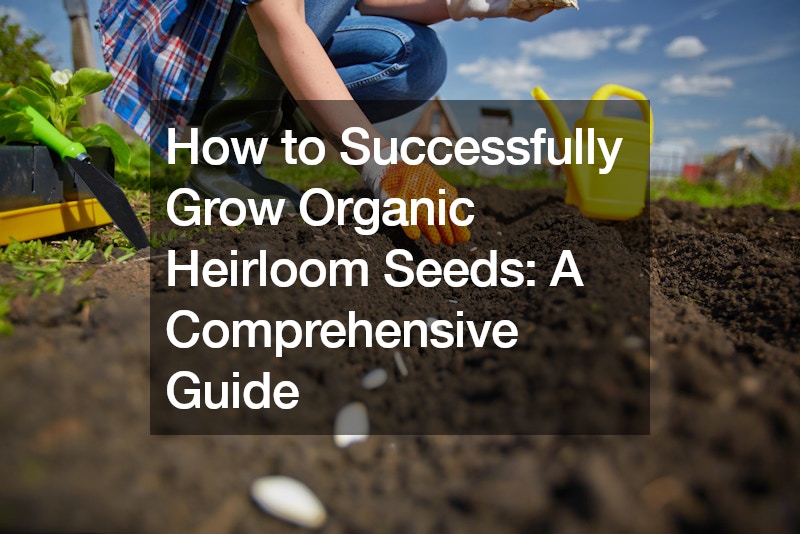
In the world of gardening, organic heirloom seeds hold a special place. These seeds, passed down through generations, offer not only the promise of delicious, unique produce but also a connection to history and tradition. Successfully growing organic heirloom seeds requires a combination of knowledge, patience, and careful cultivation techniques. In this comprehensive guide, we’ll explore the steps to ensure your organic heirloom seeds thrive and produce a bountiful harvest.
Understanding Organic Heirloom Seeds Organic heirloom seeds are more than just plants; they are living pieces of history. Unlike modern hybrid seeds, heirlooms are open-pollinated, meaning their seeds can be saved and replanted year after year. This characteristic allows gardeners to maintain the genetic diversity of these time-honored varieties.
Selecting the Right Varieties When choosing organic heirloom seeds, consider factors such as climate, soil type, and available space in your garden. Research local heirloom varieties that have adapted to your region’s conditions for better success. Look for heirloom seeds from reputable suppliers committed to organic and sustainable practices.
Preparing the Soil Organic heirloom seeds thrive in nutrient-rich, well-draining soil. Begin by testing your soil’s pH and fertility levels. Amend the soil with organic matter such as compost, aged manure, or worm castings to improve its structure and provide essential nutrients. Proper soil preparation sets the foundation for healthy seedling growth.
Planting Organic Heirloom Seeds Follow the planting instructions provided on the seed packet, taking into account factors like spacing and depth. Organic heirloom seeds can be started indoors or directly sown into the garden, depending on the variety and your climate. Ensure the soil remains consistently moist but not waterlogged during the germination period.
Caring for Seedlings Once the seeds germinate, provide them with adequate sunlight, water, and airflow. Thin seedlings as needed to prevent overcrowding and promote healthy growth. Mulch around the seedlings to conserve moisture, suppress weeds, and maintain even soil temperatures.
Organic Pest and Disease Management Keep a close eye on your organic heirloom plants for signs of pests or diseases. Implement preventive measures such as crop rotation, companion planting, and natural predators to minimize pest damage. For organic pest control, consider using insecticidal soaps, neem oil, or homemade remedies like garlic spray.
Harvesting and Saving Seeds As your organic heirloom plants mature, monitor them regularly for ripeness. Harvest fruits at their peak flavor and maturity, taking care to save seeds from the healthiest and most vigorous plants. Properly drying and storing heirloom seeds ensures their viability for future growing seasons and allows you to continue the cycle of seed saving.
Sharing the Bounty One of the joys of growing organic heirloom seeds is sharing the harvest with others. Share surplus produce with friends, family, or local community members, along with the stories behind the heirloom varieties you’ve grown. Encourage others to join in preserving these treasured plants for future generations. Organic heirloom seeds and conventional seeds represent two distinct approaches to gardening, each with its own set of characteristics and benefits. Understanding the differences between these types of seeds is crucial for aspiring gardeners looking to cultivate plants that align with their preferences and values.
Genetic Diversity: One of the key distinctions between organic heirloom seeds and conventional seeds lies in their genetic diversity. Heirloom seeds are typically passed down through generations, maintaining their genetic integrity and diversity over time. These seeds have a rich history and often come from plants that have been cultivated for their desirable traits, such as flavor, color, and resilience. In contrast, conventional seeds are often bred for specific characteristics like uniformity, yield, and shelf life, leading to a narrower genetic pool.
Chemical Treatment: Another significant difference is the approach to cultivation and the use of chemicals. Organic heirloom seeds are grown without the use of synthetic fertilizers, pesticides, or herbicides. This aligns with organic gardening principles, which prioritize soil health, biodiversity, and environmental sustainability. In contrast, conventional seeds may be treated with chemical fertilizers and pesticides during cultivation to boost growth and protect against pests and diseases. While these chemicals can be effective in the short term, they may have long-term negative impacts on soil fertility, beneficial insects, and overall ecosystem health.
Flavor and Nutritional Quality: Organic heirloom seeds are often prized for their superior flavor and nutritional quality. Because heirloom varieties have been selected for taste and texture over generations, they tend to offer a richer and more diverse culinary experience compared to conventional varieties bred for shelf life and uniformity. Additionally, organic farming practices promote soil health and nutrient cycling, which can enhance the nutritional content of fruits and vegetables grown from heirloom seeds. On the other hand, conventional seeds may prioritize traits like size, appearance, and transportability over flavor and nutritional value, resulting in produce that may be less flavorful and nutritious.
Adaptability and Resilience: Organic heirloom seeds are known for their adaptability and resilience in diverse growing conditions. Over time, heirloom varieties have developed natural defenses against pests and diseases, as well as the ability to thrive in specific climates and soil types. This adaptability is especially valuable in organic gardening, where chemical inputs are limited, and plants must rely on their inherent strengths to resist environmental stressors. In contrast, conventional seeds may be bred for high input systems, relying on chemical inputs to compensate for genetic vulnerabilities. As a result, they may be less resilient to environmental challenges and more dependent on synthetic inputs for growth and productivity.
Preservation of Biodiversity: Finally, organic heirloom seeds play a crucial role in preserving agricultural biodiversity. Many heirloom varieties are rare or endangered, representing unique genetic resources that contribute to the diversity of our food system. By growing and saving heirloom seeds, gardeners help safeguard these valuable genetic resources for future generations. In contrast, conventional agriculture often relies on a limited number of high-yielding varieties, leading to genetic homogeneity and increased vulnerability to pests, diseases, and environmental changes.
In conclusion, the choice between organic heirloom seeds and conventional seeds ultimately depends on individual preferences, gardening goals, and values. While conventional seeds may offer certain benefits in terms of yield and uniformity, organic heirloom seeds provide a unique opportunity to connect with the rich history of agriculture, support biodiversity, and enjoy the unparalleled flavor and nutritional quality of heirloom produce. By choosing organic heirloom seeds and practicing sustainable gardening methods, gardeners can cultivate a thriving garden ecosystem that nourishes both people and the planet.
.





